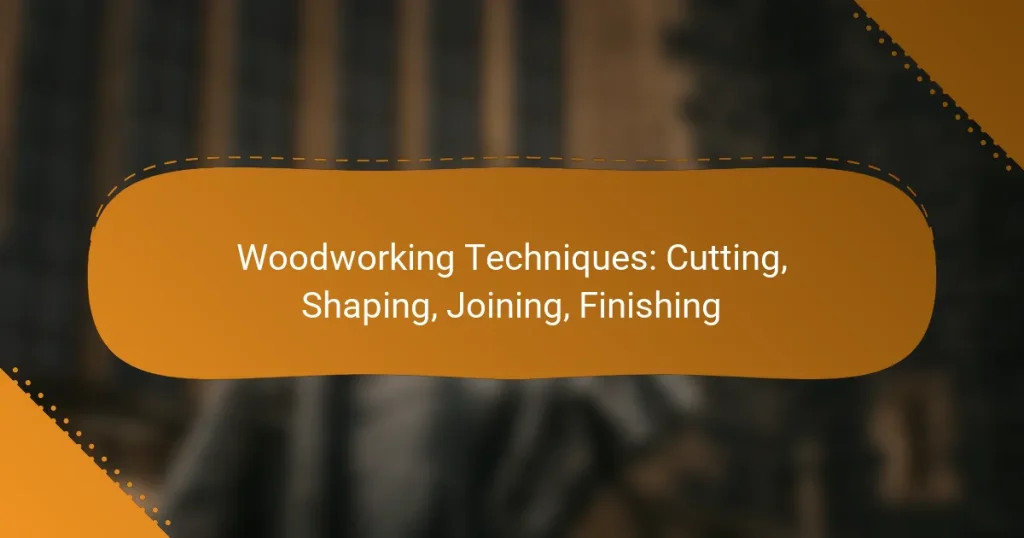Woodworking and resin crafts offer a unique blend of creativity and craftsmanship, allowing artisans to create stunning and durable pieces. By mastering fundamental woodworking techniques and incorporating resin, you can elevate your projects with vibrant colors and intricate designs. This guide will introduce you to essential skills and tools that will enhance your crafting experience and ensure safety and efficiency.
Wood Grain Techniques: Identification, Enhancement, Application
Common Mistakes in Woodworking: Planning, Measuring, Cutting
Resin Pouring Techniques: Layering, Color Mixing, Curing
Mixing Woodworking and Resin Techniques: Creativity, Compatibility, Innovation
Woodworking Techniques: Cutting, Shaping, Joining, Finishing
Joinery Techniques: Dovetail, Mortise and Tenon, Biscuit
What are the best woodworking techniques for beginners?
The best woodworking techniques for beginners include mastering basic joinery, using essential hand tools, practicing power tool safety, and applying finishing techniques. These foundational skills will help you create sturdy and visually appealing projects while ensuring safety and efficiency in your woodworking endeavors.
Basic joinery methods
Basic joinery methods are crucial for connecting pieces of wood securely. Common techniques include butt joints, lap joints, and mortise and tenon joints. Each method has its strengths; for instance, mortise and tenon joints offer superior strength for furniture, while butt joints are simpler and quicker for basic projects.
When starting, focus on mastering butt joints and lap joints, as they require minimal tools and can be reinforced with glue or screws. Always ensure your cuts are precise to achieve a tight fit, which enhances the durability of your joints.
Essential hand tool usage
Essential hand tools for woodworking include saws, chisels, planes, and measuring tools. Familiarize yourself with each tool’s purpose and proper handling techniques to maximize efficiency and safety. For example, a sharp chisel can create clean edges, while a hand saw is ideal for precise cuts.
Practice using these tools on scrap wood to build confidence. Remember to maintain your tools regularly, as sharp and well-maintained tools make the work easier and safer.
Power tool safety practices
Power tool safety practices are vital to prevent accidents in woodworking. Always wear appropriate personal protective equipment (PPE) such as safety goggles, ear protection, and dust masks. Familiarize yourself with each tool’s safety features and operating procedures before use.
Establish a clean and organized workspace to minimize hazards. Keep your hands clear of cutting areas and never bypass safety guards. Regularly inspect tools for wear and damage to ensure they operate safely.
Finishing techniques for wood
Finishing techniques enhance the appearance and durability of wood projects. Common finishes include stains, paints, and clear coats. Choose a finish based on the desired aesthetic and the wood type; for example, oil-based finishes work well on hardwoods to bring out their natural grain.
Before applying any finish, sand the wood surface to create a smooth base. Test the finish on a scrap piece to ensure it meets your expectations. Apply multiple thin coats for a professional look, allowing adequate drying time between applications.
How can I incorporate resin into woodworking projects?
Incorporating resin into woodworking projects can enhance aesthetics and durability. Techniques such as embedding objects, filling voids, or creating unique surfaces allow woodworkers to blend natural materials with colorful resin for striking results.
Resin casting basics
Resin casting involves pouring liquid resin into a mold where it hardens into a solid form. This technique is ideal for creating decorative items, tabletops, or inlays. Common types of resin used include epoxy and polyurethane, each offering different properties like curing time and finish quality.
When starting with resin casting, ensure your workspace is well-ventilated and that you wear protective gear. Familiarize yourself with the specific resin’s mixing ratio and curing time, which can vary significantly between products.
Mixing and pouring techniques
Proper mixing is crucial for successful resin projects. Measure the resin and hardener accurately, typically in a 1:1 or 2:1 ratio, depending on the product. Mix thoroughly for several minutes until the mixture is clear and free of bubbles.
When pouring, do so slowly to minimize air bubbles. Pouring in layers can help control the thickness and reduce the risk of bubbles forming. Consider using a heat gun or torch to pop any surface bubbles after pouring.
Coloring resin for effects
Coloring resin can create stunning visual effects. Use resin dyes or pigments specifically designed for this purpose, as they blend well without affecting the resin’s curing process. Start with small amounts and gradually add more until you achieve the desired shade.
Experiment with layering colors or swirling them together for unique patterns. Keep in mind that some colors may darken as the resin cures, so test a small sample first to see the final result.
What tools are essential for woodworking and resin crafts?
Essential tools for woodworking and resin crafts include a mix of hand tools and power tools that facilitate precision and creativity. Having the right equipment not only enhances the quality of your projects but also ensures safety and efficiency during the crafting process.
Must-have woodworking tools
Key woodworking tools include a saw (such as a circular saw or jigsaw), a drill, and a set of chisels. A good quality measuring tape and square are crucial for accuracy, while clamps help secure pieces during assembly or finishing.
Investing in a sturdy workbench can significantly improve your workspace. Additionally, consider safety gear like goggles and gloves to protect yourself while working with wood and power tools.
Recommended resin crafting supplies
For resin crafts, you will need epoxy resin, hardener, and mixing cups. A heat gun or torch can help eliminate bubbles in the resin, while silicone molds allow for diverse shapes and designs.
Don’t forget to use gloves and a mask to protect yourself from fumes and skin contact. High-quality pigments and additives can enhance the appearance of your resin projects, so choose those that are compatible with your resin type.
What are the common mistakes in woodworking and resin crafts?
Common mistakes in woodworking and resin crafts include overlooking safety measures, improper resin mixing ratios, and neglecting wood preparation. Addressing these issues can significantly improve the quality of your projects and ensure a safer working environment.
Overlooking safety measures
Failing to prioritize safety can lead to serious injuries in woodworking and resin crafts. Always wear appropriate personal protective equipment (PPE) such as goggles, gloves, and masks to shield yourself from dust and harmful fumes.
Additionally, ensure your workspace is well-ventilated and free of clutter. Familiarize yourself with the safety features of your tools and follow manufacturer guidelines to minimize risks.
Improper resin mixing ratios
Using incorrect resin mixing ratios can result in a failed project, with issues like incomplete curing or a sticky finish. Typically, a 1:1 ratio is common for many epoxy resins, but always check the manufacturer’s instructions for specific guidelines.
To avoid mistakes, measure your resin and hardener carefully using a scale or graduated cups. Mixing in small batches can also help ensure accuracy and prevent waste.
Neglecting wood preparation
Proper wood preparation is crucial for achieving a smooth finish and strong adhesion in resin projects. Sanding the wood surface before applying resin helps remove imperfections and allows the resin to bond effectively.
Ensure the wood is clean and dry, as moisture can interfere with resin curing. Consider sealing the wood with a suitable primer or sealant to prevent air bubbles from forming during the resin application.
How do I choose the right wood for resin projects?
Choosing the right wood for resin projects involves selecting types that bond well with resin and have desirable aesthetic qualities. Look for hardwoods with minimal knots and defects to ensure a smooth finish and strong adhesion.
Types of wood suitable for resin
Common woods suitable for resin projects include oak, maple, and walnut. These hardwoods are dense and provide a strong foundation for resin applications, ensuring durability and a polished look. Softwoods like pine can also be used, but they may not hold up as well over time.
Exotic woods such as mahogany and teak are also popular due to their unique grain patterns and colors, which can enhance the visual appeal of the finished product. When selecting wood, consider both the structural integrity and the aesthetic qualities you want to achieve.
Considerations for wood grain and color
The wood grain and color play a crucial role in the final appearance of resin projects. A pronounced grain can create striking contrasts when paired with clear or colored resin, while smoother grains may result in a more uniform look. Choose wood with interesting patterns to add depth and character to your piece.
When considering color, think about how the wood will interact with the resin. Lighter woods can brighten the overall look, while darker woods may provide a more dramatic effect. Test small samples with resin to see how the colors blend before committing to larger pieces.
What are the best practices for finishing resin projects?
The best practices for finishing resin projects include proper curing, sanding, and applying protective coatings to enhance durability and appearance. Following these steps ensures a smooth, glossy finish while preventing common issues like cloudiness or scratches.
Polishing techniques for resin
Polishing resin involves several steps to achieve a clear, glossy surface. Start by sanding the cured resin with progressively finer grits, typically ranging from 120 to 2000 grit, to remove imperfections. After sanding, use a polishing compound specifically designed for resin to buff the surface, which can restore clarity and shine.
Common polishing tools include rotary polishers and microfiber cloths. A rotary polisher can speed up the process, but be cautious of overheating the resin, which can cause damage. For best results, work in small sections and apply consistent pressure.
Applying protective coatings
Applying a protective coating is essential for preserving the finish of resin projects. Options include epoxy topcoats, polyurethane, or specialized resin sealers. Each type offers different levels of UV resistance and durability, so choose based on the intended use of the item.
Before applying any coating, ensure the resin surface is clean and free of dust. Use a soft brush or spray application for even coverage, and allow sufficient drying time as per the manufacturer’s instructions. Regular maintenance, such as reapplying the coating every few years, can significantly extend the life of your resin projects.
How can I sell my woodworking and resin crafts?
To sell your woodworking and resin crafts, consider utilizing online platforms, local markets, and social media to reach potential buyers. Each method has its advantages, so choose the ones that best fit your products and target audience.
Online marketplaces for artisans
Online marketplaces provide a convenient way to showcase and sell your woodworking and resin crafts to a global audience. Popular platforms like Etsy, Amazon Handmade, and eBay allow artisans to set up shops with minimal upfront costs.
When selecting an online marketplace, consider factors such as fees, audience reach, and ease of use. For instance, Etsy focuses on handmade and unique items, attracting customers specifically looking for artisan goods, while Amazon Handmade offers access to a broader customer base but with higher fees.
To maximize your success, invest time in creating high-quality listings with clear photos and detailed descriptions. Regularly update your shop and engage with customers to build a loyal following. Avoid common pitfalls like neglecting customer service or failing to promote your products on social media.






